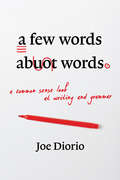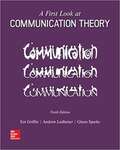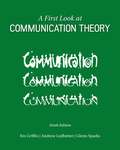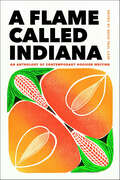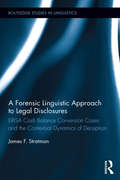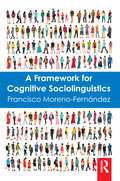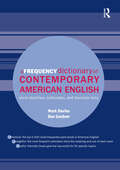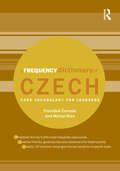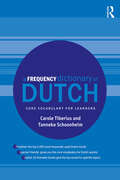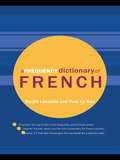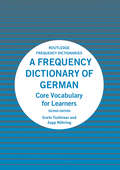- Table View
- List View
A Few Words About Words
by Joseph J. DiorioHONORED AS A NOTABLE 100 BOOK IN THE 2021 SHELF UNBOUND BEST INDIE BOOK COMPETITIONFINALIST FOR THE 2021 FOREWORD INDIES AWARDSPenned by a writer who had to teach himself the rules of English grammar, A Few Words About Words offers an easy and accessible approach to understanding and using the English language.In a world dominated by countless print and social media outlets, written communication is king. Writing "your" when you mean "you're" and "there" when you mean "they're" can make the difference between getting or not getting new business. A missing comma can result in a PR catastrophe, and a well-written line can be remembered for generations. And yet, many native speakers struggle with the English language.Spawned from the widely-circulated and beloved newsletter of the same name, Joe Diorio's A Few Words About Words blends quick-witted anecdotes from more than 30 years of newsletter entries that highlight the common, uncommon, and surprising grammar mistakes most English speakers make. The result is a digestible, all-encompassing look at English grammar.Humorous, enlightening, and completely comprehensible, A Few Words About Words will be the go-to grammar guide you pick up and can't put down.
A Fictional Commons: Natsume Soseki and the Properties of Modern Literature
by Michael K. BourdaghsModernity arrived in Japan, as elsewhere, through new forms of ownership. In A Fictional Commons, Michael K. Bourdaghs explores how the literary and theoretical works of Natsume Sōseki (1867–1916), widely celebrated as Japan's greatest modern novelist, exploited the contradictions and ambiguities that haunted this new system. Many of his works feature narratives about inheritance, thievery, and the struggle to obtain or preserve material wealth while also imagining alternative ways of owning and sharing. For Sōseki, literature was a means for thinking through—and beyond—private property. Bourdaghs puts Sōseki into dialogue with thinkers from his own era (including William James and Mizuno Rentarō, author of Japan’s first copyright law) and discusses how his work anticipates such theorists as Karatani Kōjin and Franco Moretti. As Bourdaghs shows, Sōseki both appropriated and rejected concepts of ownership and subjectivity in ways that theorized literature as a critical response to the emergence of global capitalism.
A Field Guide to Community Literacy: Case Studies and Tools for Praxis, Evaluation, and Research
by Laurie A. Henry Norman A. StahlThis practical guidebook presents trends, research-grounded strategies, and field-based solutions to challenges of working in community-based literacy initiatives. A comprehensive guide for practitioners, this book addresses best practices for implementing, maintaining, expanding, and evaluating community-based literacy initiatives. The contributors in this volume help readers shift thinking from merely considering, "How can communities support literacy?" to "How can literacy help us create, support, and strengthen communities?" Organized into four parts – on building community through literacy, program design, case studies from the field, and program evaluation – chapters cover research-based and innovative practices in a diverse range of populations and settings, including family services, adult literacy initiatives, community centers, and tutoring programs. With an abundance of praxis-oriented examples and real-world strategies from top scholars and practitioners, the book serves as a roadmap for essential topics, including funding, writing grant proposals, handling audits, and conducting research within program settings. With templates, models, planning tools, and checklists ready for immediate use, this book is an invaluable field manual for individuals involved in community literacy work, researchers, and students in literacy-oriented courses either at the undergraduate or graduate levels.
A Field Guide to Narnia
by Colin DuriezFrom the Book jacket: Whether this is your first visit or you've been there many times, you'll want to bring along this handy guide to the landscape and inhabitants of Narnia. You'll learn more about the mind behind Narnia, how Narnia relates to other imaginative worlds and children's literature, the history within the stories of Narnia, and how Narnia fits into Lewis's other work. This book will help you dig deeper into the series and its implications for understanding the Christian life. "Colin Duriez . . . provides profound insight into the brilliant mind and prolific writings of C. S. Lewis. By carefully interweaving the life experiences of Lewis with an analysis of his vast body of scholarly and popular works-especially his Chronicles of Narnia- Mr. Duriez provides the reader with new understanding and a strong motivation to read the works again and again."
A Figure of Speech: A Festschrift for John Laver
by W. J. Hardcastle J. Mackenzie BeckThroughout the world, there are phoneticians who have been influenced by the teaching, research, and writings of John Laver. Many have worked with him personally, and most of the contributors to this book are people with whom he has had special links or whose involvement represents an appreciation of the breadth of Laver's interests. While the book is meant to be a tribute to John Laver, the topics have been chosen to provide an overview of some key issues in phonetics, with illuminating contributions from some of the most influential academics in the field. Contributing to this festschrift are William Hardcastle, Janet Mackenzie Beck, Peter Ladefoged, John J. Ohala, F. Gibbon, Anne Cutler, Mirjam Broersma, Helen Fraser, Peter F. MacNeilage, Barbara L. Davis, R. E. Asher, E. L. Keane, G. J. Docherty, P. Foulkes, Janet Fletcher, Catherine Watson, John Local, Ailbhe Ní Chasaide, Christer Gobl, John H. Esling, Jimmy G. Harris, and Francis Nolan.
A Fine Coat (Book 6)
by Barbara W. MakarDecodable Storybooks 2A accompany More Workbook 2 and provide additional opportunity to apply the phonetic concepts introduced in Workbook 2 to connected text. The storybooks use the same vocabulary as Workbook 2 and Storybooks 2 with the addition of one sight word was. Storybooks 2A are an excellent tool to reinforce the skills from Workbook 2 and can be used with either Workbook 2 or More Workbook 2"--Epsbooks.com.
A First Look At Communication Theory
by Andrew Ledbetter Emory A. Griffin Glenn Grayson SparksThe 11th edition of A First Look at Communication Theory encourages students who are encountering the field for the first time to tackle theories without fear. The authors’ conversational style and relevant examples keep complex theories within the grasp of first-time theory students. They introduce over 30 diverse theories that are a mix of foundational and recent scholarship and, with the benefit of numerous examples and connections to pop culture, help students apply them to their own lives. The discrete presentation of the theories ensures a well-rounded understanding of each while promoting integrative thinking and facilitating the ability of instructors to skip or rearrange their presentation. The broad selection of theories-from the classics to the cutting edge-ensures that students have a solid foundation with which to begin understanding the relationships between theories.
A First Look at Communication Theory
by Glenn Sparks Em Griffin Andrew LedbetterThe tenth edition of A First Look at Communication Theory justifies again the program's enduring popularity. EM Griffin, now joined by colleagues Andrew Ledbetter and Glenn Sparks, encourages students who are encountering the field for the first time to tackle theories without fear. <p><p> The text's conversational style and relevant examples keep complex theories within the grasp of first-time theory students. The authors introduce 32 diverse theories that are a mix of foundational and recent scholarship and, with the benefit of numerous examples and connections to pop culture, help students apply them to their own lives. The discrete presentation of the theories ensures a well-rounded understanding of each while promoting integrative thinking and facilitating the ability of instructors to skip or rearrange their presentation. <p><p> The broad selection of theories-from the classics to the cutting edge-ensures that students have a solid foundation with which to begin understanding the relationships between theories.
A First Look at Communication Theory (Ninth Edition)
by Glenn Sparks Em Griffin Andrew LedbetterThe ninth edition of A First Look at Communication Theory justifies again the program's enduring popularity. Em Griffin, now joined by colleagues Andrew Ledbetter and Glenn Sparks, encourages students who are encountering the field for the first time to tackle theories without fear. The authors introduce 32 diverse theories that are a mix of foundational and recent scholarship and, with the benefit of numerous examples and connections to pop culture, help students apply them to their own lives. This program ensures that students have a solid foundation with which to begin understanding the relationships between theories.
A Flame Called Indiana: An Anthology of Contemporary Hoosier Writing
by Doug Paul CaseAs Kurt Vonnegut, Indiana's most famous writer, once remarked, "Wherever you go, there is always a Hoosier doing something important there."A Flame Called Indiana features 65 writers of fiction, nonfiction, and poetry who have all had the pleasure of being Hoosiers at one time or another. Curated by the Indiana University Bloomington creative writing department, this diverse anthology features everything from the immigrant experience to the Indianapolis 500 to science fiction. Altogether, the work stands testament to the vibrancy and creativity of this Midwest state.An excellent gift for your favorite reader and an important resource for creative writers, A Flame Called Indiana serves as both a chronicle of where Indiana's writing is today and a beacon to those who'll take it where it's going next.
A Floating Chinaman: Fantasy and Failure across the Pacific
by Hua HsuWho gets to speak for China? During the interwar years, when American condescension toward China yielded to fascination with all things Chinese, a circle of writers sparked an unprecedented conversation over U.S.-Chinese relations. Hua Hsu tells how they became ensnared in bitter rivalries over who could claim the title of leading China expert.
A Forensic Linguistic Approach to Legal Disclosures: ERISA Cash Balance Conversion Cases and the Contextual Dynamics of Deception (Routledge Studies in Linguistics)
by James StratmanThis book is a scholarly work of forensic linguistics that demonstrates how the principles of Gricean pragmatics and their recent elaboration in Information Manipulation Theory (IMT) can be of use to courts faced with deciding cases of allegedly fraudulent disclosure documents. The usual goal of legal rules for disclosure documents is not merely to prevent lying but other forms of deception as well. In particular, the goal of these rules is to force the communicator to reveal information that could cause material harm to certain receivers, harms that the communicator, for various reasons of self-interest, might prefer to keep secret or hidden. Because IMT and the Gricean framework have seldom been used in published studies to investigate legally mandated disclosure documents aimed at laypersons, this book seeks to enrich current explications of the rhetorical "workings" of deceptive disclosures within the broader Gricean tradition of pragmatics. The book questions the fundamental relationships among Grice’s maxims as well as the much circulated notion that violation of some maxims is more deceptive and more immoral than violations of others. In addition, the book also attempts to show how various other theories and research in discourse linguistics and reading comprehension can be used to support IMT analyses in addressing the discourse processing issues unique to legally required disclosure texts. In this way the book contributes to the larger dual mission of the field of forensic linguistics, which is both to understand and to improve courts’ impact on social justice.
A Formal Approach to Discourse Anaphora (RLE: Discourse Analysis)
by Bonnie Lynn WebberFirst published in 1979, this book starts from the perspective that dealing with anaphoric language can be decomposed into two complementary tasks: 1. identifying what a text potentially makes available for anaphoric reference and 2. constraining the candidate set of a given anaphoric expression down to one possible choice. The author argues there is an intimate connection between formal sentential analysis and the synthesis of an appropriate conceptual model of the discourse. Some of the issues with the creation of this conceptual model are discussed in the second chapter, which follows a background to the thesis that catalogues the types of anaphoric expression available in English and lists the types of things that can be referred to anaphorically. The third and fourth chapters examine two types of anaphoric expression that do not refer to non-linguistic entities. The final chapter details three areas into which this research could potentially be extended. This book will be of interest to students of linguistics.
A Formalist Theatre
by Michael KirbyMichael Kirby presents a penetrating look a theater theory and analysis. His approach is analytically comprehensive and flexible, and nonevaluative. Case studies demonstrate this unique approach and record performances that otherwise would be lost.
A Fractured Landscape of Modernity
by James WilkesThis book uses the contradictions, fractures and coincidences of a twentieth-century rural landscape to explore new methods of writing place beyond 'new nature writing'. In doing so it opens up new ways of reading modernist artists and writers such as Vanessa Bell, Mary Butts and Paul Nash.
A Framework for Cognitive Sociolinguistics
by Francisco Moreno-FernandezA Framework for Cognitive Sociolinguistics attempts to lay out the epistemological system for a cognitive sociolinguistics—the first book to do so in the English language. The intention of this volume is not to provide a simple catalog of sociolinguistic principles or of theoretical postulates of a cognitive nature, but rather it aims to build a verifiable metatheoretical basis for cognitive sociolinguistics. This book is articulated through a series of propositions, accompanied by annotations and commentaries that develop, qualify and exemplify these propositions. As for the research questions that would be central to a cognitive sociolinguistic endeavor, the following incomplete catalog could be enumerated: What do speakers know about their language? What do they know about communicative interaction? What do speakers know about sociolinguistic variation? Where does that knowledge reside and how is it configured? How does social reality influence the origin and processing of language? How does language use affect the configuration, evolution and variation of language? What do speakers know about their socio-communicative context? How do speakers perceive sociolinguistic reality? What are speakers’ attitudes and beliefs regarding linguistic variation? How does sociolinguistic perception influence speakers’ communicative behavior at all levels? How does language contribute to the construction of identity? Offering a fresh perspective on the frequently taught and studied topic of cognitive linguistics, A Framework for Cognitive Sociolinguistics can easily be incorporated into existing courses in the areas of both cognitive and sociocultural linguistics.
A Freedom Bought with Blood
by Jennifer C. JamesIn the first comprehensive study of African American war literature, Jennifer James analyzes fiction, poetry, autobiography, and histories about the major wars waged before the desegregation of the U.S. military in 1948. Examining literature about the Civil War, the Spanish-American Wars, World War I, and World War II, James introduces a range of rare and understudied texts by writers such as Victor Daly, F. Grant Gilmore, William Gardner Smith, and Susie King Taylor. She argues that works by these as well as canonical writers such as William Wells Brown, Paul Laurence Dunbar, and Gwendolyn Brooks mark a distinctive contribution to African American letters.In establishing African American war literature as a long-standing literary genre in its own right, James also considers the ways in which this writing, centered as it is on moments of national crisis, complicated debates about black identity and African Americans' claims to citizenship. In a provocative assessment, James argues that the very ambivalence over the use of violence as a political instrument defines African American war writing and creates a compelling, contradictory body of literature that defies easy summary.
A Frequency Dictionary of British English: Core Vocabulary and Exercises for Learners (Routledge Frequency Dictionaries)
by Vaclav Brezina Dana GablasovaA Frequency Dictionary of British English provides information about the frequency and distribution of words in British English. The dictionary presents rich information about word frequencies and distributions in an accessible manner. In addition to textual and numerical information, the dictionary offers a range of visualisations to help understand the statistical properties of words. These visualisations are especially important for pedagogical uses of the book. This book also includes vocabulary exercises for learners of English to activate their vocabulary with the help of the dictionary. The dictionary is based on extensive research on current British English using the British National Corpus 2014, a 100-million-word corpus of contemporary British English developed at Lancaster University. The corpus represents a wide range of genres/registers of spoken and written English, including informal speech, fiction, newspapers, academic writing and e-language. Additional support materials for this book are available at https://lancslex.lancs.ac.uk This dictionary is designed to meet the needs of a wide variety of users interested in current British English vocabulary including students, educators, journalists, material developers and researchers.
A Frequency Dictionary of Contemporary American English: Word Sketches, Collocates and Thematic Lists (Routledge Frequency Dictionaries)
by Mark Davies Dee GardnerFirst published in 2010 . Routledge is an imprint of Taylor & Francis, an informa company.
A Frequency Dictionary of Contemporary Arabic Fiction: Core Vocabulary for Learners and Material Developers (Routledge Frequency Dictionaries)
by Laila FamiliarA Frequency Dictionary of Contemporary Arabic Fiction provides a list of the top 2,000 words occurring in contemporary Arabic fiction. Based on a written corpus that contains 144 literary samples, the dictionary addresses key areas of Arabic language learning and teaching, including lexical frequency, reading skills, and Arabic literature. Each entry in the main frequency index includes a sample sentence, English translation, and frequency indicator, and alphabetical and part-of-speech indexes are provided for ease of use. The dictionary also contains 19 thematically organized and frequency-ranked lists of words on a variety of topics, such as food, places, emotions, and nature. Engaging and highly useful, this Frequency Dictionary is a valuable resource for students and instructors working in the area of TAFL, and for applied linguists interested in Arabic corpus linguistics.
A Frequency Dictionary of Czech: Core Vocabulary for Learners (Routledge Frequency Dictionaries)
by František Cermák Michal KrenA Frequency Dictionary of Czech is an invaluable tool for all learners of Czech, providing a list of the 5,000 most frequently used words in the language. Based on data from a 100 million word corpus and evenly balanced between spoken, fiction, non-fiction and newspaper texts, the dictionary provides the user with a detailed frequency-based list, as well as alphabetical and part of speech indexes. All entries in the rank frequency list feature the English equivalent, a sample sentence with English translation and an indication of register variation. The dictionary also contains twenty thematically organised and frequency-ranked lists of words on a variety of topics, such as family, food and drink and transport. A Frequency Dictionary of Czech enables students of all levels to get the most out of their study of vocabulary in an engaging and efficient way. It is also a rich resource for language teaching, research, curriculum design, and materials development. A CD version is available to purchase separately. Designed for use by corpus and computational linguists it provides the full text in a format that researchers can process and turn into suitable lists for their own research work.
A Frequency Dictionary of Dutch: Core Vocabulary for Learners (Routledge Frequency Dictionaries)
by Carole Tiberius Tanneke SchoonheimA Frequency Dictionary of Dutch is a valuable tool for all learners of Dutch, providing a list of the 5,000 most frequently used words in the language. Based on a 290 million word corpus which includes both written and spoken material from a wide range of sources, this dictionary presents Dutch core vocabulary in a detailed and clearly arranged manner: each of the 5,000 entries includes English equivalents and a sample sentence showing language in use. Users can access the top 5,000 words either through the main frequency listings or an alphabetical index. Throughout the frequency listings there are thematically organized lists featuring the top words from a variety of key topics such as animals, food and other areas of daily and cultural life. Words specific to Dutch in Belgium (Belgian Dutch) are also included. An engaging and efficient resource, A Frequency Dictionary of Dutch will enable students of all levels to get the most out of their study. This book was prepared in association with the Instituut voor Nederlandse Lexicologie (INL, Institute of Dutch Lexicology). A CD version is available to purchase separately. Designed for use by corpus and computational linguists, it provides the full text in a format that researchers can process and turn into suitable lists for their own research purposes.
A Frequency Dictionary of French: Core Vocabulary for Learners (Routledge Frequency Dictionaries)
by Deryle Lonsdale Yvon Le BrasA Frequency Dictionary of French is an invaluable tool for all learners of French, providing a list of the 5000 most frequently used words in the language. Based on a 23-million-word corpus of French which includes written and spoken material both from France and overseas, this dictionary provides the user with detailed information for each of the 5000 entries, including English equivalents, a sample sentence, its English translation, usage statistics, and an indication of register variation. Users can access the top 5000 words either through the main frequency listing or through an alphabetical index. Throughout the frequency listing there are thematically-organized lists of the top words from a variety of key topics such as sports, weather, clothing, and family terms. An engaging and highly useful resource, the Frequency Dictionary of French will enable students of all levels to get the most out of their study of French vocabulary. Deryle Lonsdale is Associate Professor in the Linguistics and English Language Department at Brigham Young University (Provo, Utah). Yvon Le Bras is Associate Professor of French and Department Chair of the French and Italian Department at Brigham Young University (Provo, Utah).
A Frequency Dictionary of German: Core Vocabulary for Learners (Routledge Frequency Dictionaries)
by Erwin Tschirner Jupp MöhringThis completely updated edition of A Frequency Dictionary of German contains the 5,000 most commonly used words of German today, occurring in a 20 million word corpus (compared to a 4.2 million corpus in the first edition). The basis of the frequency list is a significantly extended version of the Herder/BYU Corpus of Contemporary German. The Dictionary contains spoken and written German, and represents different genres, text types, registers, styles, and also regional varieties. The corpus is designed to represent the current German language as it is used in real world. Useful as a reference for students and course designers alike, A Frequency Dictionary of German is an important new resource.
